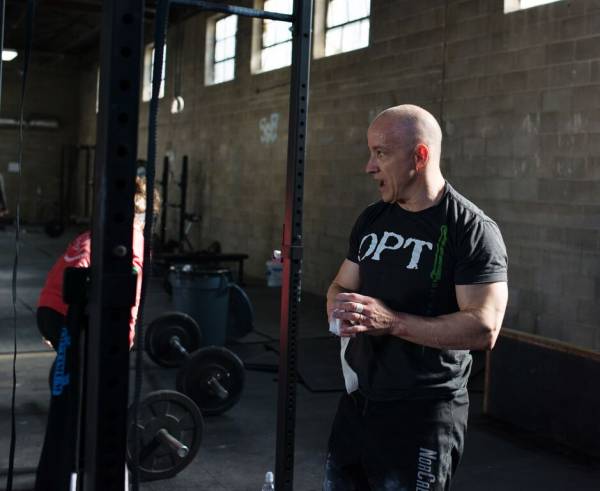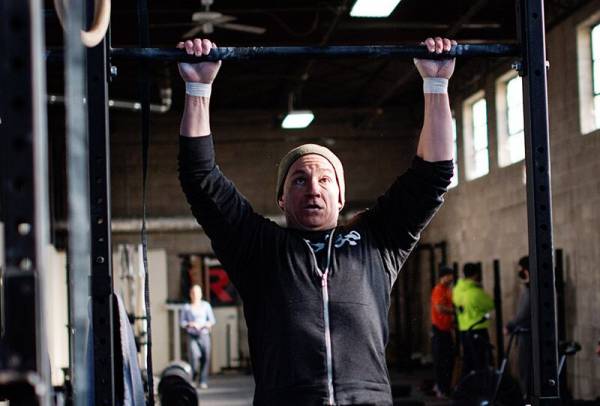I am always somewhat envious of my friend George, a weightlifter at my gym, Cincinnati Strength and Conditioning. George is 25 years old and he waltzes into the box, changes his clothes, and before I can finish rolling my quads, he is already warming up with a 185lb snatch. Young, flexible, and seemingly invincible.
The Difference Between 25 and 52
As for me, at the age of 52, my warm up begins right before I leave the house, when I down three Advil. I kid you not, this is necessary for me as a pre-workout. I do not recommend this by any means, but for me, the difference between a great training session and a really bad one is Advil.
Unlike my young friend George, it takes me about thirty minutes to warm up before I get under the bar.
I have a lot of minor aches and pains in my wrists, knees, and shoulders, and the Advil helps to take the edge off that pain. It allows me to work without fear, which is often the difference between making a lift and not making a lift. When I have a bar in my hands about to jerk 225lbs, if I have not taken Advil, no amount of warming up will help that to feel like it’s not shearing off my ulna from my radius.
But once I arrive at the gym, the warm up begins in earnest. For masters athletes, and that would include anyone forty and above, I highly recommend a warm up that is no less than thirty minutes. This may seem like a bit much, especially if you are used to participating in group classes and the warm up is typically a 400m run plus some PVC overhead squats. That, I am afraid, is insufficient.
“You need to first get the blood flowing, then get your dynamic stretch on from top to bottom, then work your way through all of the movements you’ll be doing in the workout.”
In fact, one of the quickest ways to injure yourself is to jump into a high-intensity workout when you’re cold. For example, nothing aggravates the muscles of your forearms more than pull ups when you have not sufficiently warmed up that movement. Why do we have elbow pain? Because we have inflamed the brachioradialis and the extensor carpi radialis longus with pulling before those muscles were warm.
So how can you warm up your entire body and keep yourself injury free? This is what I do, and I have been nearly injury free my entire CrossFit career. Add or modify as your age and needs require.
It Starts With Blood Flow
One of the best ways to keep yourself injury free and make sure you get oxygen to every last capillary is to get the blood flowing. And this doesn’t need to be a 400m run or row to begin the workout. It might mean hopping on the rower every five or six minutes for 200m, throwing in some double unders, or jogging out 100m and back, a little more intensely each time over the course of your thirty-minute warm up. Get creative.

Warming up this way helps me maintain an injury-free CrossFit career.
Next Up: Mobilize
The next thing I do is to mobilize everything. I am not talking about rolling on a foam roller or stretching with a band, although those pieces have their place and may be effective for you. Instead, I choose to get very dynamic in my movement.
- Starting at the wrists, I clasp my hands together and rotate.
- Next, it’s down on my knees with palms on the floor, fingers facing every which way, as I gently roll around unlocking the wrists.
- From there, I start worming my way up in what looks like a half-assed attempt at a push up that is, in fact, a very intentional build-up to a couple of push up. I literally gradually work my way up to a push up. I can power clean 275lbs, so I can definitely do a push up. But I also warm up very slowly.
- Once I am done pushing up, I get up and rotate the arms at full bore, left, right, forward, and backward. I continue this rotation even as I am walking around grabbing my shoes, turning up the music, or looking for chalk. You can never do too many arm circles.
Those Adductors, Though
The biggest lower-body mobility issue for me is my adductors, or the groin muscle. If that is tight, I have no mobility in the lower end of my squat. So, what I do is drop down into a full deep squat and push out on my knees with my elbows. I do this off and on every five or six seconds or so. The goal? Loosen up so I can open up my knees as I squat and not have those tight muscles pulling me forward.
“If you are a masters athlete, the class warm up is just not enough. A run around the block followed by squats and mountain climbers is not sufficient to prep you for a tough workout.”
I don’t worry much about warming up glutes and hamstrings unless I am running. The reason being that I want these tight, not loose, when I snatch and clean. These muscles are like rubber bands in that I would rather have tension in them when I go to execute a lift, and as long as I have sufficient blood flow, I am not worried about a pull or a tear.
Bars, Pull Ups, Muscle Ups
If I am working with a bar in any way, be it snatches, cleans, or squats, I start with an empty bar. I start by racking it, and then just bringing my wrists up and back, elbows up, really pushing the boundaries of the stretch. My goal here is that when I do my first clean, I don’t want it to feel like the first time I have touched the bar that day, especially on my chronically tight and sore wrists.

I never attempt pull ups without first moving slowly through the motions to loosen up.
I then proceed to hold the bar in jerk position, push it slowly overhead, back down, back up, and so on. Lots of basic warm up reps, while at the same time I am pausing to tape various pressure points. (I use a lot of athletic tape. Almost an embarrassing amount. I like to tape off any pinch point so that when I pull, I am not thinking about something that hurts. Instead, I am thinking about proper execution of the lift.)
For pull ups and dips, my first rep is never a full rep. I start by hanging from the bar. From there, I pull a bit, then a little more, then up to a half pull up, then a full pull up. By the end of my warm up, I should be jogging around the room keeping the blood flowing and executing two or three pull ups in butterfly fashion.
Laugh if You Want, But…
Three things to keep in mind:
- I am 52 years old.
- I have never sustained a serious injury and the only time I have ever pulled something is when I have failed to warm up properly. I have never injured myself doing the workouts themselves, but a lack of proper warm up will leave me raked for days.
- If you are a masters athlete, the class warm up is just not enough. A run around the block followed by squats and mountain climbers is not sufficient to prep you for a tough workout. You need to first get the blood flowing, then get your dynamic stretch on from top to bottom, then work your way through all of the movements you’ll be doing in the workout, building up slowly to your working weight or reps, so once the “3-2-1-go” occurs, you are well oiled.
Check out these related articles:
- An 8-Week Longevity-Based Program for Masters Weightlifters
- Call Me Old One More Time – I Dare You
- What Makes Masters Competition Different Than Regular Competition?
- What’s New On Pulse Beat Fit Today
Photos courtesy of Patrick McCarty.






